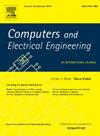Optimal configuration for improved system performance of droop-controlled DC microgrid with distributed energy resources and storage
IF 4
3区 计算机科学
Q1 COMPUTER SCIENCE, HARDWARE & ARCHITECTURE
引用次数: 0
Abstract
The placement of sources and loads in DC microgrids (DCMGs) influences the system’s voltage regulation, span, and losses. In order to minimize losses and enhance voltage regulation, a unique algorithm for configuring a radial DCMG under droop control in an optimal way is presented in this paper. The suggested approach solves the optimal design problem by applying the power flow analysis technique. The genetic algorithm (GA), a heuristic method, is used to determine the ideal configuration because of the complexity of the optimization problem. An improved particle swarm optimization (IPSO)-based technique is also proposed for resolving the optimization issue to improve the convergence rate and computing efficiency. Appropriate modifications are proposed to yield an optimal configuration that results in the maximum achievable span for the radial, droop-controlled DCMG. To limit the bus voltage variations within the bounds, the objective functions of the optimization problem are appropriately formulated. In addition, the proposed algorithm is used to find the best position and power rating of a new distributed energy resource (DER) or load in the DCMG, in order to reduce system losses. A 5-bus, 500 W, radial, droop-controlled DCMG system’s comprehensive numerical and simulation results are presented to validate the effectiveness of the proposed approaches. The findings are significant and useful for DCMG consumers as well as system designers.
改善带分布式能源资源和储能的降压控制直流微电网系统性能的优化配置
直流微电网(DCMG)中的电源和负载位置会影响系统的电压调节、跨度和损耗。为了最大限度地减少损耗并提高电压调节能力,本文提出了一种独特的算法,用于以最优方式配置下垂控制下的径向 DCMG。所建议的方法通过应用功率流分析技术来解决优化设计问题。由于优化问题的复杂性,本文采用了一种启发式方法--遗传算法(GA)来确定理想配置。为解决优化问题,还提出了一种基于改进粒子群优化(IPSO)的技术,以提高收敛速度和计算效率。提出了适当的修改建议,以获得最佳配置,从而实现径向、垂变控制 DCMG 的最大可实现跨度。为将母线电压变化限制在一定范围内,对优化问题的目标函数进行了适当表述。此外,所提出的算法还可用于寻找新的分布式能源资源 (DER) 或负载在 DCMG 中的最佳位置和额定功率,以减少系统损耗。本文介绍了一个 5 总线、500 W、径向、下垂控制 DCMG 系统的综合数值和仿真结果,以验证所提方法的有效性。研究结果对 DCMG 消费者和系统设计者具有重要的参考价值。
本文章由计算机程序翻译,如有差异,请以英文原文为准。
求助全文
约1分钟内获得全文
求助全文
来源期刊

Computers & Electrical Engineering
工程技术-工程:电子与电气
CiteScore
9.20
自引率
7.00%
发文量
661
审稿时长
47 days
期刊介绍:
The impact of computers has nowhere been more revolutionary than in electrical engineering. The design, analysis, and operation of electrical and electronic systems are now dominated by computers, a transformation that has been motivated by the natural ease of interface between computers and electrical systems, and the promise of spectacular improvements in speed and efficiency.
Published since 1973, Computers & Electrical Engineering provides rapid publication of topical research into the integration of computer technology and computational techniques with electrical and electronic systems. The journal publishes papers featuring novel implementations of computers and computational techniques in areas like signal and image processing, high-performance computing, parallel processing, and communications. Special attention will be paid to papers describing innovative architectures, algorithms, and software tools.
 求助内容:
求助内容: 应助结果提醒方式:
应助结果提醒方式:


